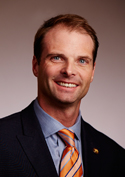
Sean T. Grambart, DPM, FACFAS
ACFAS President
“Goals achieved with little effort are seldom worthwhile or lasting.” —John Wooden
My last perspective. This is a hard one because I’m looking backward rather than forward. This is a special year for ACFAS—our 75th anniversary. Four men, average age 31, incorporated the American College of Foot Surgeons (no ankle until 1992) and started working on its original mission: to serve as a “qualifying organization that would set the rules and regulations for foot surgery.” Bottom line: ACFS started out as what you know today as ABFAS.
As I started to write this, I thought about how things have changed in the last 75 years. In 1942, the United States was in turmoil with World War II. The average household income was $1,880, a new home was $6,900 and a new car was $1,100. Fast forward to today and some believe the United States is still in turmoil with the War on Terror. The household income is $48,100, a new house costs $280,000 and a new car averages 33,500. But we likely still have many of the same concerns and stresses that people did in 1942. In fact, the biggest difference that I could find is that the St. Louis Cardinals won the World Series in 1942, and today the Chicago Cubs hold the title. Miracles do happen!
I wondered what changed and what stayed the same over the last 75 years for our profession and ACFAS. Thanks to the efforts of Jerry Noll, DPM, FACFAS, and Kenneth Durr, PhD, we now know. As part of our anniversary, the College has published The Evolution of a Profession: The First 75 Years of the American College of Foot and Ankle Surgeons 1942–2017. It is eye-opening to read how far we’ve come and how it was ACFS/ACFAS that transformed chiropody to podiatry to today’s surgical practice.
The four founders of the College, Drs. Douglas Mowbray, Oswald Roggenkamp, Lester Walsh and Lowell Purgett set down our founding principles: “To foster a bond of fellowship among foot surgeons, to bring practitioners and students a realization of the results that can be gained, to teach finished or standard techniques, to constantly strive to develop additional techniques, and to act as a protective agent for the public and for the profession.” These goals haven’t changed much in 75 years. In fact, aside from some wording, these are still part of our bylaws and strategic compass. But, I think our own Founding Fathers would be proud to see where the College is today and how we’re the force that always pushes the envelope for more and improved education, training, certification and research.
As I reflect back on the last year, I am proud of what the College has achieved and the contributions of our members. I would like to thank everyone for all of the efforts that they have given to achieve these goals. Whether it is volunteering on a committee or being active with a residency or at a local hospital, every contribution to the common good raises the tide for us all.
So what will the College and our profession look like at our centennial in 2042? Full, unfettered professional equality? Ankle privileges in all 50 states? The lowest rate of complications of any surgical specialty? Universal healthcare? No one knows, but I’m pretty confident our core principles will be the same—to serve society as the preeminent source of knowledge for foot and ankle surgery and to advance the competency of our members and the care of our patients.
I now turn this space over to our new president, Laurence G. Rubin, DPM, FACFAS. It has been an honor and a privilege to serve the College this past year. Thank you.
